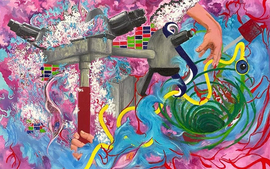Restricted resource
We are excited to reveal the 2023 winner, who explored the future impact of pathology in celebration of the NHS's 75th anniversary. Congratulations to Dr Sally Ashton, who recently completed the first year of her foundation training. You can read Dr Ashton's winning essay in full below.
How do you think pathologists will shape healthcare over the next 75 years?
Pathologists have long been the gatekeepers to the advancement of medicine. Since the first scientific human cadaveric dissection carried out by Herophilus (325–255 BC), to the futuristic realms of next-generation sequencing, pathology continues to break boundaries.
Lateral flow assays (LFAs) have long been used as an at-home method to detect pregnancy. Since the COVID-19 pandemic, public worldwide are familiar with this technology as a means of ascertaining infection status. Recent studies are using LFAs to detect circulating long non-coding RNA as a biomarker for malignancy by taking advantage of their disease-specific mode of expression.1 Will the future see both LFA and liquid biopsy technology, which isolates circulating tumour cells, DNA and cell-free DNA,2 achieving early, precise cancer diagnoses with a user-friendly interface that patients could use to screen themselves for malignancies?
The versatility of LFAs is also promising; while currently used for applications such as the detection of diseases in both humans and animals, chemicals, pollutants and toxins,3 research continues to widen their usage, for example, in the rapid detection of Klebsiella and Raoultella in food products.4 In the coming decades, will LFAs be an everyday over-the-counter purchase for a public that is empowered to screen for new pandemic infections, commonplace pathogens, hormones, medication levels, malignancy, water and food purity from their own homes?
Home may well be the future for pathologists, thanks to advancements in digital pathology. As the infrastructure and quality of resources continues to improve, pathologists may find themselves inspiring change in the medical workforce as this new technology enables them to split working hours between office and home, and to enjoy flexible working hours, thanks to the availability of digital slides. In a climate of long working hours, inflexible leave and exhausted medics, is pathology the beacon of hope for a change in working conditions among doctors?
Digital pathology also heralds a new era in international collaboration among pathologists. Instead of relying on slides being physically sent to colleagues for a second opinion, new technology enables almost instantaneous sharing worldwide. The enhanced pathology network that this will entail would have a positive impact on global healthcare not only in providing expert diagnoses faster, but also drawing together relevant expertise to take on global health challenges.
As COVID-19 has demonstrated, alongside Ebola virus and Salmonellosis, zoonoses are a global side effect of humankind’s close relationship to animals and the natural world.5 As the world’s ever-increasing population continues to impact on the natural environment, microbiologists and virologists will continue to play a key role in prompt identification of emerging pathogens and the prevention of future pandemics, equipped to work safely from home in a socially distanced setup.
An additional challenge to tackling future outbreaks is that of antimicrobial resistance. Although not a new issue, it is one that remains unresolved. The rapid spread of ‘superbugs’, the threat of novel pathogens and a global reliance on antibiotics from both healthcare and food industries remind us of the importance of developing new antimicrobial solutions. In recent years, WHO identified only 6 antibiotics as innovative among the 32 in clinical development for treatment of their list of priority pathogens.6 Does the future of antibiotics lie in gene editing, as a recent study has suggested?
CRISPR-Cas9 gene editing has recently been shown to successfully manipulate key assembly-line enzymes, which can be used to produce new antibiotics.7 Will this be the technology that saves us from catastrophic outbreaks, or could the answer lie in targeting specific mechanisms of antibiotic resistance? Recent development of a DsbA inhibitor that impairs antibiotic resistance in strains of key bacteria, including E. coli and K. pneumoniae, offers an optimistic glimpse of the intelligent antimicrobials of the coming years.8
In the future, haematologists may also offer life-changing enhancements on a global level with the development of blood-stabilising products for use in transfusion. The swift degradation of blood products once harvested or thawed presents logistical limitations. A recent study found that polysaccharide Ficoll 70 kDa could enhance the stability of whole blood samples used for investigation and diagnostics.9 Will the future see this technology being used to prolong the viability of blood products for transfusion, enabling their easier transportation in war zones and developing countries?
Similarly, whereas today, blood products must be stringently matched to ensure blood-type compatibility with the transfusion recipient, studies have long been underway to develop an enzyme that removes A/B antigens from red blood cells. Scientists look to parasites, bacteria and the human gut microbiome to discover organisms that degrade these antigens, making universal donor blood a future reality.10 This technology may even enable universal organ donation, banishing transplant rejection and the need for immunosuppressants to the past.
The plastic pandemic is a multi-faceted problem and the effects of micro and nanoplastics on the health of both humans and animals has raised concerns as more is discovered about their impact. Indeed, ingested microplastics have been found in the bodies of deep-sea amphipods living in some of the planet’s deepest ocean trenches.11 While these minute particles may be omnipresent, effective techniques to detect them are still being fine-tuned. At present, combined use of physical microscopical modalities, such as scanning electron microscopy, and chemical techniques, including spectroscopy, are commonly used, although identification of varying microplastics particle composition, size and shape still represents a challenge.12 Does the future lie in something entirely new, such as digital holography?
This innovative process harnesses machine learning and holographic coherent imaging to provide more accurate identification of plastic particles.13 As this technology improves, both veterinary and human histopathology may not only shine light on the extent of the issue, but may also demonstrate the role of micro and nanoplastics in disease mechanisms and their infiltration within the food chain.
In efforts to explain disease and develop ways to combat health issues world over, pathologists continue to look more closely, on ever-finer scales, to navigate the minutiae of DNA, pathogen behaviour, digital technologies and entirely new challenges from our changing environments to shape a way forward for our future healthcare.
References available on the website.
Return to January 2024 Bulletin homepage
Read next
Art of Pathology Competition – our 2023 winners!
18 January 2024



